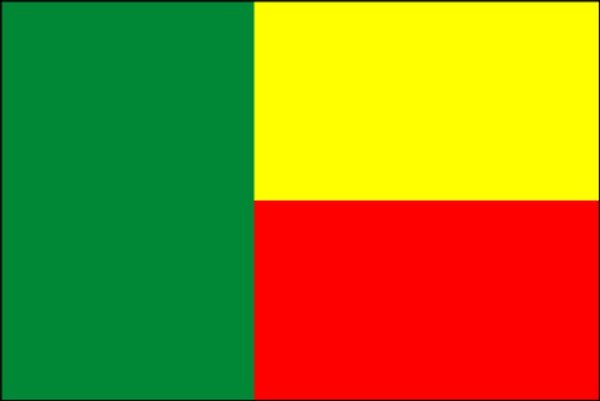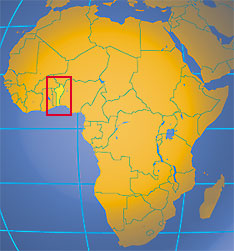 A country of western Africa, Benin was originally made up of several ancient kingdoms colonized by France in the 19th century, and was known as the Republic of Dahomey. It became independent in 1960 and was renamed the Republic of Benin in 1975. Porto-Novo is the capital though Cotonou the largest city.
A country of western Africa, Benin was originally made up of several ancient kingdoms colonized by France in the 19th century, and was known as the Republic of Dahomey. It became independent in 1960 and was renamed the Republic of Benin in 1975. Porto-Novo is the capital though Cotonou the largest city.
Between 1960 and 1972, a succession of military coups brought about many changes of government. The last of these brought to power Major Mathieu Kérékou as the head of a regime professing strict Marxist-Leninist principles. By 1975 the Republic of Dahomey changed its name to the Republic of Benin. The Revolutionary Party of the People of Benin (PRPB) remained in complete power until the beginning of the 1990s. Kérékou, encouraged by France and other democratic powers, convened a national conference that introduced a new democratic constitution and held presidential and legislative elections. Kérékou’s principal opponent at the presidential poll, and the ultimate victor, was Prime Minister Nicéphore Soglo. Supporters of Soglo also secured a majority in the National Assembly.
Benin was the first African country to effect successfully the transition from dictatorship to a pluralistic political system. In the second round of National Assembly elections held in March 1995, Soglo’s political vehicle, the Parti de la Renaissance du Benin, was the largest single party but lacked an overall majority. The success of a party formed by supporters of ex-president Kérékou, who had officially retired from active politics, allowed him to stand successfully at both the 1996 and 2001 presidential elections.
Benin’s economy is overwhelmingly agricultural, with most workers engaged in subsistence farming. The chief crops are cotton, corn, cassava, yams, beans, palm oil, peanuts, and cashews. Goats, sheep, and pigs are raised. There is a sizable freshwater fishing industry, and some ocean fish are also caught. Most of Benin’s few manufactures are processed agricultural goods, basic consumer items, textiles, and building materials.
Petroleum, discovered offshore of Porto-Novo in 1968, and limestone are extracted. The country’s other mineral resources, which include chromite, low-quality iron ore, ilmenite, and titanium, have not as yet been exploited. There is also a developing tourist industry. The country has limited rail and road systems, and they are almost exclusively in the southern and central parts of the country; rail lines are being extended to Niger. A hydroelectric plant completed in 1988 on the Mono River was a collaborative effort between Togo and Benin.
The chief imports are foodstuffs, capital goods, and petroleum products. The principal exports are cotton, cashews, shea butter, textiles, palm products, and seafood. The annual cost of imports usually exceeds earnings from exports. The leading trade partners are China, France, Thailand, Nigeria, and Indonesia.
Beninese literature had a strong oral tradition long before French became the dominant language.[19] Felix Couchoro wrote the first Beninese novel, L’Esclave in 1929.
Post-independence, the country was home to a vibrant and innovative music scene, where native folk music combined with Ghanaian highlife, French cabaret, American rock, funk and soul, and Congolese rumba.
Singers Angélique Kidjo and actor Djimon Hounsou were both born in Cotonou, Benin. Composer Wally Badarou and singer Gnonnas Pedro are also of Beninese descent.
Although there are 42 ethnic groups in Benin, its population is divided into four main ethnolinguistic groups-Fon, Yoruba, Voltaic, and Fulani. The Fon-speakers, who live in the south, include the Fon, or Dahomey (Benin’s largest single ethnic group), Aja, Peda, and Chabe subgroups. The Yoruba live in the southeast near Nigeria, the group’s main homeland. The Voltaic-speakers live in central and N Benin and include the Bariba and Somba subgroups. The Fulani live in the north. French is the country’s official language; Fon, Yoruba, and other indigenous tongues are also spoken. About a third of the inhabitants follow traditional religious beliefs; voodoo originated here some 350 years ago but was only officially recognized in 1996. About 43% are Christian (largely Roman Catholic) and 25% (living mostly in the north) are Muslim. Benin’s population is concentrated in the southern portion of the country and in rural areas.
Recent migrations have brought other African nationals to Benin that include Nigerians, Togolese, and Malians. The foreign community also includes many Lebanese and Indians involved in trade and commerce. The personnel of the many European embassies and foreign aid missions and of nongovernmental organizations and various missionary groups account for a large part of the 5500 European population. A small part of the European population consists of Beninese citizens of French ancestry, whose ancestors ruled Benin and left after independence.

Notes from Wikipedia and Answers.com








